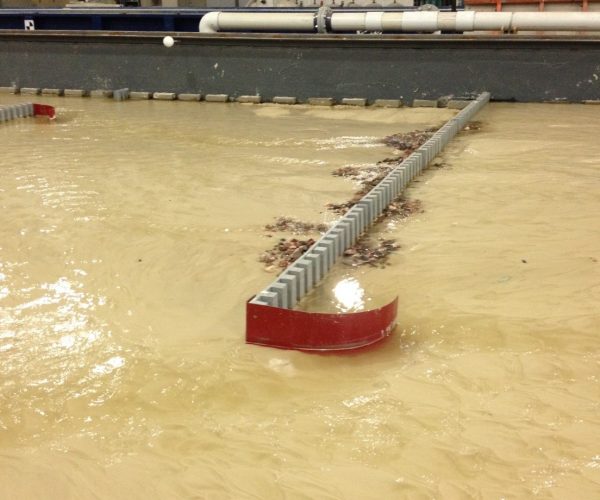Physical Model Studies

Capabilities
Over 20,000 square feet of covered laboratory space is available in the main Hydraulics Lab for model studies. Outdoor flumes are available and can be used for near-prototype-size studies. An additional facility can be used to construct large scale, custom flume configurations. Flow rates range from 0 to 200 cfs. Flume widths range from 8 inches to 20 feet. Custom flumes have been built as large as 50 feet wide and 250 feet long in the past. Previous physical model studies have included dams, spillways, sediment transport studies, recreational whitewater features, river diversions, and many more.
Common Physical Models
- Reaches of river
- Erosion and sedimentation models
- All types of spillways
- Diversion structures
- Intake structures
- Bridge waterway hydraulics and scour
- Fish passage structures
- Energy dissipation structures
- Recreational whitewater features
Previous Physical Model Studies
The projects below are a small sample of the many types of physical model studies undertaken at the laboratory.
Illinois River
Location – Marseilles Canal at Marseilles Lock and Dam on the Illinois River
Scale – 1:70
This study used a hydraulic model used to investigate the magnitude of water crosscurrents in the upstream, navigation approach to the Marseilles Canal at Marseilles Lock and Dam on the Illinois River. The navigation channel approach near Marseilles Canal is aligned close to the south side of the dam; the canal leads to the navigation lock at Marseilles, Illinois.
Gross Dam Spillway
Location – Boulder County, Colorado
Scale – 1:24
CSU has partnered with Denver water and their design engineers to create a scale hydraulic model of Gross Reservoir’s new proposed spillway. Reservoir storage will be increased 77,000 acre-feet by raising Gross Dam 131 feet, providing additional water supply and stability to Denver’s fast growing population. The existing smooth spillway will be replaced with a new steeper, stepped spillway in addition to a new stilling basin. CSU has worked with the design engineers to verify and measure air concentration and pressures along the spillway as well as refine the stilling basin design for best performance. CSU was honored to be involved in such a unique project that is close to home.
For more information on the project see Denver Water’s Gross Reservoir Expansion project website here.
River Run Whitewater Park
Location – South Platte River, Denver, Colorado
Scale – 1:6
CSU partnered with McLaughlin Whitewater Design Group to test and refine recreational whitewater features to be used by kayakers and river surfers. A total of six drop structures were tested and are now built that create recreational waves that can be surfed or kayaked. McLaughlin Whitewater has pioneered and patented the use of mechanical WaveShapers™ that can tailor these waves to the rider and also the river flow rate. McLaughlin and CSU spent considerable time fine tuning head water and tail water elevations, and inlet conditions to change wave size, shape, quality, etc.
For more information see McLaughlin Whitewater’s website here.




Grade Building Structures
Location – North Fork of the Toutle River, Washington
Scale – 1:80
This study involved a hydraulic model designed and used to provide insights into the performance of a barrier walls forming a grade-control structure to retain bed sediment along a reach of the North Fork of the Toutle River, which drains a watershed on the flank of Mt. St. Helens, Washington. The barrier-wall concept is a potential part of an overall approach the U.S. Army Corps of Engineers implemented for managing sediment in the watershed.